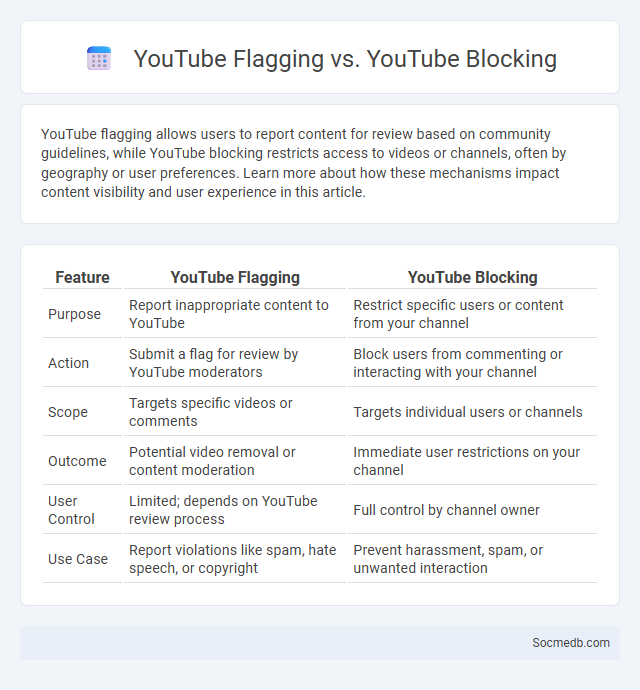
Photo illustration: YouTube Flagging vs YouTube Blocking
YouTube flagging allows users to report content for review based on community guidelines, while YouTube blocking restricts access to videos or channels, often by geography or user preferences. Learn more about how these mechanisms impact content visibility and user experience in this article.
Table of Comparison
| Feature | YouTube Flagging | YouTube Blocking |
|---|---|---|
| Purpose | Report inappropriate content to YouTube | Restrict specific users or content from your channel |
| Action | Submit a flag for review by YouTube moderators | Block users from commenting or interacting with your channel |
| Scope | Targets specific videos or comments | Targets individual users or channels |
| Outcome | Potential video removal or content moderation | Immediate user restrictions on your channel |
| User Control | Limited; depends on YouTube review process | Full control by channel owner |
| Use Case | Report violations like spam, hate speech, or copyright | Prevent harassment, spam, or unwanted interaction |
Introduction to YouTube Content Regulation
YouTube content regulation involves policies and guidelines designed to maintain a safe and positive environment for viewers while protecting creators' rights. These regulations address issues such as copyright infringement, hate speech, misinformation, and inappropriate content, ensuring that Your videos comply with community standards. Understanding YouTube's algorithm and enforcement mechanisms can help you avoid penalties and maximize your content's reach.
What is YouTube Flagging?
YouTube Flagging is a system that allows users to report videos violating community guidelines, such as inappropriate content, copyright infringement, or harmful behavior. When you flag a video, it triggers a review process where YouTube's moderators assess the content and take necessary actions like removal or age restriction. Ensuring your flagged concerns are specific and accurate can improve the platform's safety and content quality for all users.
How Does YouTube Blocking Work?
YouTube blocking works by restricting access to specific videos or channels based on copyright claims, community guidelines violations, or government regulations, ensuring content complies with platform policies. Your content might be blocked in certain countries or regions due to local laws or licensing agreements. YouTube uses automated systems and manual reviews to detect and enforce these blocks, maintaining a safe and legal environment for viewers worldwide.
Flagging vs Blocking: Key Differences
Flagging on social media involves reporting content to platform moderators for review due to violations of community guidelines or inappropriate behavior, aiming to maintain a safe and respectful environment. Blocking, on the other hand, restricts specific users from interacting with your profile, preventing them from viewing your posts or contacting you directly. Understanding the distinction helps you manage your online interactions effectively, ensuring your social media experience remains secure and positive.
Impact of Flagging on Content Creators
Flagging by users significantly influences content creators' visibility and monetization opportunities on social media platforms. Frequent flagging can lead to content removal, demonetization, or account suspension, directly affecting creators' revenue streams and audience reach. This mechanism also encourages adherence to community guidelines, shaping the quality and type of content produced.
Impact of Blocking on Audience Reach
Blocking users on social media significantly reduces your audience reach by restricting the visibility of your content to certain individuals, which limits engagement and interaction metrics. This action can decrease overall impressions and hinder organic growth, as blocked users can no longer share or comment on your posts. Maintaining a strategic balance in managing your audience is crucial to optimize reach and foster a positive community environment.
Community Guidelines: When to Flag
You should flag content on social media that violates community guidelines, including hate speech, harassment, or explicit material. Reporting harmful posts helps maintain a safe environment and protects users from abuse and misinformation. Ensuring your online community adheres to these standards strengthens trust and promotes respectful interactions.
Consequences of Repeated Flagging or Blocking
Repeated flagging or blocking on social media platforms can lead to account suspension or permanent bans, severely restricting your ability to engage with content and communities. Algorithms may also limit the visibility of your posts, reducing your reach and influence across the platform. These consequences emphasize the importance of adhering to community guidelines to maintain a positive online presence.
User Roles in Flagging and Blocking
Users play a critical role in maintaining community standards by flagging inappropriate content and blocking harmful accounts. Flagging helps social media platforms identify and review posts that violate guidelines, ensuring timely removal of spam, hate speech, or misinformation. Blocking empowers users to control their online experience by preventing interactions with specific individuals, fostering safer and more personalized digital environments.
Best Practices for Responsible Flagging
Responsible flagging on social media involves accurately identifying harmful or inappropriate content such as hate speech, misinformation, or harassment while avoiding false reporting. Users should familiarize themselves with platform-specific community guidelines and report violations with clear evidence to support prompt and effective moderation. Consistently practicing thoughtful flagging contributes to a safer online environment by helping platforms enforce their standards and protect vulnerable users.
 socmedb.com
socmedb.com